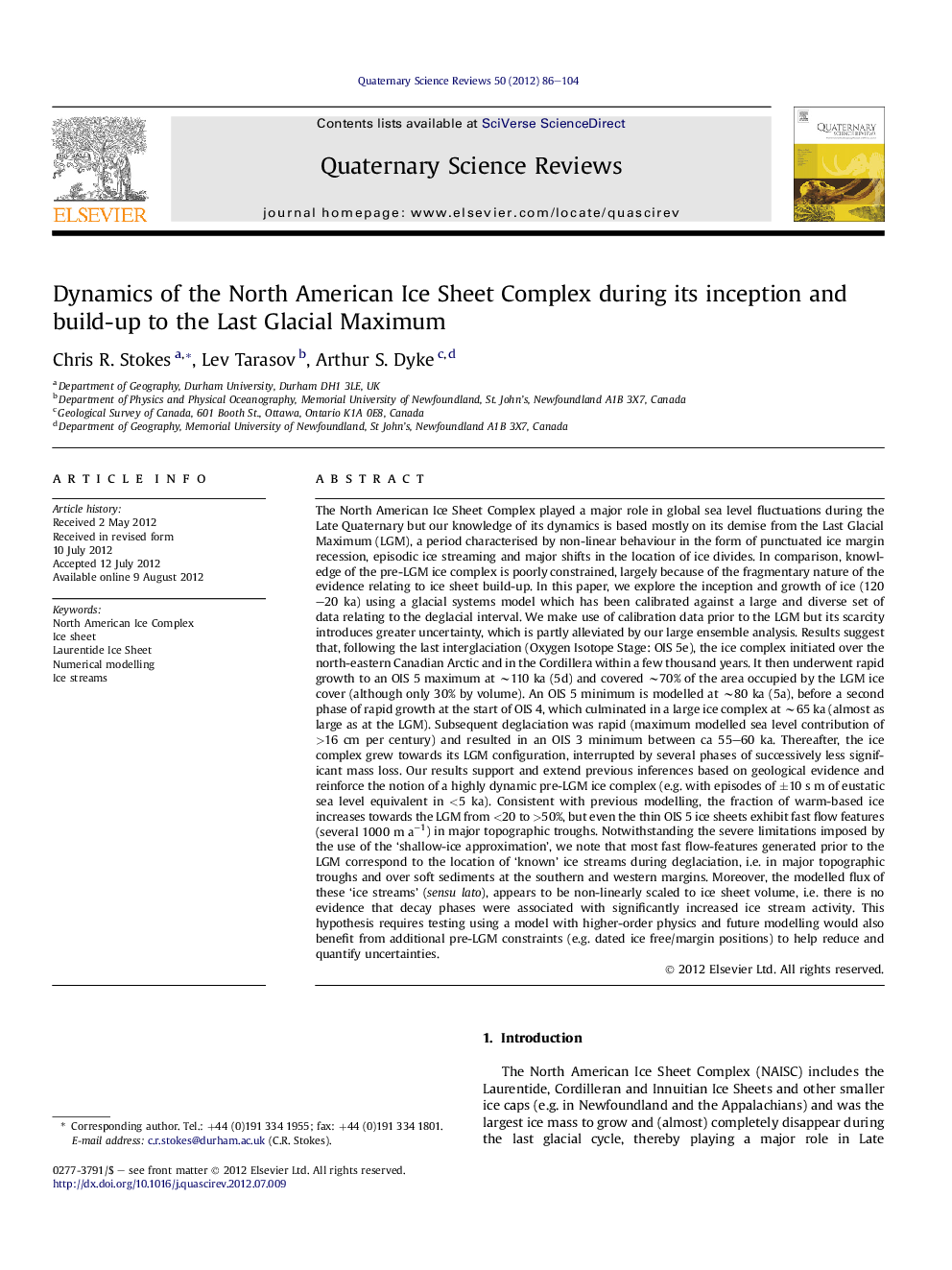| کد مقاله | کد نشریه | سال انتشار | مقاله انگلیسی | نسخه تمام متن |
|---|---|---|---|---|
| 4735727 | 1640884 | 2012 | 19 صفحه PDF | دانلود رایگان |

The North American Ice Sheet Complex played a major role in global sea level fluctuations during the Late Quaternary but our knowledge of its dynamics is based mostly on its demise from the Last Glacial Maximum (LGM), a period characterised by non-linear behaviour in the form of punctuated ice margin recession, episodic ice streaming and major shifts in the location of ice divides. In comparison, knowledge of the pre-LGM ice complex is poorly constrained, largely because of the fragmentary nature of the evidence relating to ice sheet build-up. In this paper, we explore the inception and growth of ice (120–20 ka) using a glacial systems model which has been calibrated against a large and diverse set of data relating to the deglacial interval. We make use of calibration data prior to the LGM but its scarcity introduces greater uncertainty, which is partly alleviated by our large ensemble analysis. Results suggest that, following the last interglaciation (Oxygen Isotope Stage: OIS 5e), the ice complex initiated over the north-eastern Canadian Arctic and in the Cordillera within a few thousand years. It then underwent rapid growth to an OIS 5 maximum at ∼110 ka (5d) and covered ∼70% of the area occupied by the LGM ice cover (although only 30% by volume). An OIS 5 minimum is modelled at ∼80 ka (5a), before a second phase of rapid growth at the start of OIS 4, which culminated in a large ice complex at ∼65 ka (almost as large as at the LGM). Subsequent deglaciation was rapid (maximum modelled sea level contribution of >16 cm per century) and resulted in an OIS 3 minimum between ca 55–60 ka. Thereafter, the ice complex grew towards its LGM configuration, interrupted by several phases of successively less significant mass loss. Our results support and extend previous inferences based on geological evidence and reinforce the notion of a highly dynamic pre-LGM ice complex (e.g. with episodes of ±10 s m of eustatic sea level equivalent in <5 ka). Consistent with previous modelling, the fraction of warm-based ice increases towards the LGM from <20 to >50%, but even the thin OIS 5 ice sheets exhibit fast flow features (several 1000 m a−1) in major topographic troughs. Notwithstanding the severe limitations imposed by the use of the ‘shallow-ice approximation’, we note that most fast flow-features generated prior to the LGM correspond to the location of ‘known’ ice streams during deglaciation, i.e. in major topographic troughs and over soft sediments at the southern and western margins. Moreover, the modelled flux of these ‘ice streams’ (sensu lato), appears to be non-linearly scaled to ice sheet volume, i.e. there is no evidence that decay phases were associated with significantly increased ice stream activity. This hypothesis requires testing using a model with higher-order physics and future modelling would also benefit from additional pre-LGM constraints (e.g. dated ice free/margin positions) to help reduce and quantify uncertainties.
► We present numerical modelling of the North American Ice Sheet from 120 to 20 ka.
► Early inception in the north-eastern Canadian Arctic from ca 118 ka.
► Rapid growth to a large but thin OIS 5d ice sheet at 110 ka, followed by shrinkage.
► Rapid growth and decay of major OIS 4 ice sheet, almost as large as LGM ice.
► Find a scaling between overall ice stream flux and ice volume from 120 to 20 ka.
Journal: Quaternary Science Reviews - Volume 50, 12 September 2012, Pages 86–104